| The
ProblemAs detailed in
the review, the Hammer triangle type rip fence is totally unacceptable for
use; it is far inferior to other fences on the market. I have also used the
"B3L" fence system, although it certainly is a step up from the triangle type,
it is incredibly inferior to the aftermarket fences I am familiar with. Due to the
obvious shortcomings of European rip fence systems, I began to search for
alternatives. It has also become obvious to me that most likely all low to mid level
European saws are equipped with inferior rip fence systems. The comment below for
installing decent aftermarket American systems should hold true with some variation to
nearly any brand of Euro saw that I am aware of. Full 5 function combination
machines are another matter, their jointer / planer table configurations present a host of
new problems but these too could be solved with enough Yankee ingenuity. This
article does not deal with the issues in fitting a new fence to a "full" combo
machine.
The Ideal
My ideal rip fence system would have the following characteristics in order of importance: |
| 1 |
Very rigid when locked
down. |
| 2 |
Accurate and repeatable. |
| 3 |
Slides easily along the
rail. |
| 4 |
Easy to "micro
adjust" or sneak-up on a desired reading. |
| 5 |
Has a minimum 32" rip
capacity. |
| 6 |
Can be easily lifted off
and replaced. |
| 7 |
Rigid fence section that
can be slid backwards to point in front of the blade - very important for a sliding
tablesaw. |
| 8 |
When used at the maximum
rip capacity, does not increase to footprint of the saw by any great amount. This also
implies that the saw does not have to be moved in order to use the full capacity of the
system. |
| 9 |
Does not decrease or have
detrimental effects upon machine mobility if it has a mobility kit installed. |
| 10 |
Be very easy to adjust the
measuring "cursor". |
| 11 |
Is easy to install and
adjust. |
| 12 |
Has a fence section that
can be used without laminates getting under the fence. |
| 13 |
Has a fence section that
can be made to present a low height section towards the blade, useful for ripping thin
stock and for preventing the blade from hitting the fence when tilted. |
| 14 |
Has a fence section that
can be used to easily mount jigs and accessories. |
To my knowledge, there is no aftermarket fence system available that will fit the Hammer
that has all the characteristics listed above.Options
I very early on ruled out the Felder rip fence as a viable option due to
the reports of problems, cost, an lack of engineering commitment by Felder. In my
opinion, the two incredibly inferior Hammer fences (which are made by the same company as
the Felder fence) has twice demonstrated a failure of their engineers to adequately design
a rip fence, there is no reason for anyone to "experiment" with them further.
The main reason there aren't several aftermarket
fence systems that can be fitted to the Euro saws is that it does not have room for the
typically very wide "T-square" type fence head, the sliding table gets in the
way.
All of these solutions listed below would require the extension
table to be replaced or modified greatly. To me, replacing the extension table is not a
big issue. However, if I were to go to all the trouble of replacing the extension, I would
impose the following additional requirements on it:
- Must be a continuos surface, not segmented like the original.
- The surface must be adjustable independent of the rip fence system
to align with the iron table easily and precisely.
- Should not require any legs that need adjustment when the machine
is moved or interfere with machine mobility.
- Not be supported by the rip fence rail(s) in such a way that
induces an alignment relationship between the two.
- Easy to install.
- Have a reasonably durable surface.
|
|
|
Biesemeyer Clone
The home shop version of the
Biesemeyer clone seems like it would be easier to modify for this application with its
smaller T-square head. However it would be a little more difficult than the
"pro" version to install because the rails are closer to the plane of the iron
table than the "pro" version. This limits how closely the fence can come to the
blade without modification.
The easiest way to get the fence to go all the way to the blade
would be to add another fence onto the left side of the standard one. The best
implementation of this would be to use a system similar to the Unifence wherein the new
fence surface could be slid back to act as a stop or even rotated 90 degrees to provide
the low profile section.
In the illustration shown, the type of fence used is either an
Accufence or Modulus unit; I would select these over a Biesemeyer or Jet Exacta. Because
it was easier to draw (I had it drawn already) I show the added fence section as a
Unifence extrusion which is held on by a large T-bolt assembly just like it is on the
standard Unifence system. Although three nuts are shown to secure the added fence, only
two are required at any one time.
Because the T-square section of the Accufence is 16 inches wide,
to fit it as shown below would require cutting about 2 inches off of the left side. This
would further require the replacement of the top wear pad on the left and a re-building of
the left interior wear /alignment pad. Although the clamping action would be somewhat
asymmetrical because of the 2 inch loss on the left, it should not have a measurable
negative effect. If it did have an impact, two inches could be cut off of the T-square
section on the right as well.
To support the fence rail attachment angle, a three bolt
arrangement could be used; two of the bolts would be in the iron table and a third (or
more) in the new right extension table. Because the infeed side of the Hammer iron table
is not milled 90 degrees to the surface, this poses anther problem to installation,
getting the angle iron installed square to the plane of the iron table. This could be
solved with tapered shims or set screws in the iron table or rail angle to offset the
taper of the iron table.
With this system, items 1, 2, 3, 5, 6, 7, 8, 9, 10, 11, 12, &
13 of the ideal fence system can be achieved. The main detriment of this fence system is
cost and a well-known issue of an un-parallel fence when it is moved; this doesn't affect
accuracy and could be resolved by technique. Another detriment would be the cost of the
base fence and an additional (Unifence like) extrusion. The main benefit of a system like
this is that the Accufence locks down very rigidly and could probably be used with a stock
feeder; by combining the rigidity of the Accufence and the sliding fence section of the
Unifence, this should be a very robust and versatile solution.
|
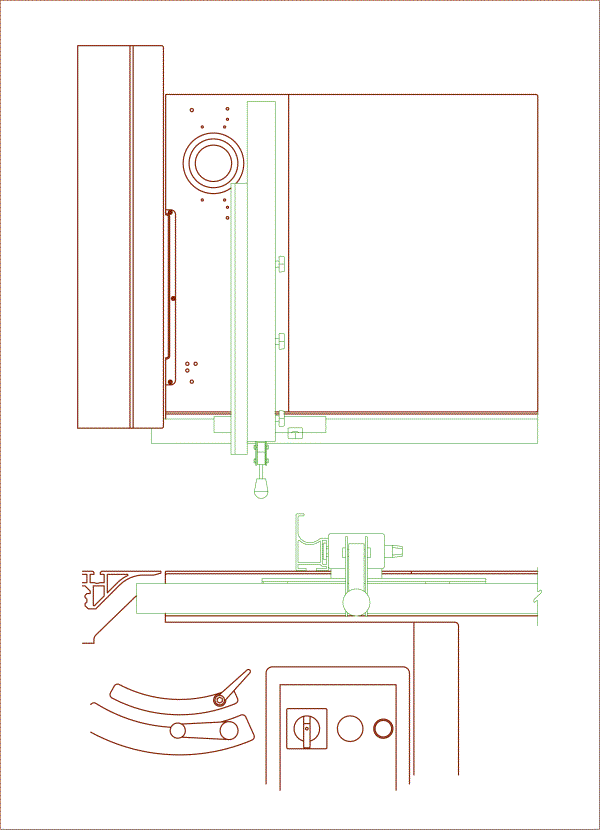
|
Jointech Saw Train / Incra TSIII
On both of theses offerings
the bridge that spans across the rails is not long enough to make it across the large
table of a European machine. Also, the fence is not long enough to span the table which
will not allow both fore / aft auxiliary lock-down devises to be used. In my measurements
of the Clincher system described above, both these systems may be rigid enough without
them anyway unless a power feeder is used. The clincher system was measured to be just as
rigid (statically) as the Unifence and measurably better than either of the Hammer fences.
To install either of these systems, the rails would have to be
bolted to both sides of the iron table and the extension table support with the same
difficulty as the Biesemeyer type systems. To span the larger distance between the rails a
replacement bridge (that the positioning machine is attached to) must be built or obtained
from the maker. The standard bridge is lightweight aluminum which would be
preferable to a shop-made substitute made from heavier material.
With either of these systems, items 1, 2+, 3, 4, 5, 9, 10, 11,
& 14 of the ideal fence system can be achieved along with one noteworthy additional
improvement. These systems are inherently more repeatable and precise than other fence
systems. These fences add a feature not found on the other systems listed herein.
Because they were derived from router table systems they have incorporated a push fixture
which could be used as a small miter gauge. The sliding table on the Euro saw would
perform the miter gauge function better most of the time but there are instances where a
push fixture on the fence would be either easier / quicker or one desires the high
accuracy these fences provide. This type of fence system does require a sizeable
open space to the right of the machine to operate to full capacity.
|
Delta Unifence
This basically is a European
fence design in every way except the "T-square" head is still a problem in this
application. In order overcome the shortfall, a spacer could be inserted between the head
and the fence section.
To support the fence rail, a three-bolt arrangement could be
used; two of the bolts would be in the iron table and the third near the end of a new
right extension table. The Unifence rail has the same difficulty attaching to the
non-milled iron table edge as the Accufence. However, because of the Unifence head design,
the rip fence rail would not have to be exactly 90 degrees to the plane of the table, just
close.
To get the fence up to the blade it is offset with spacer about 2
inches thick. The spacer is bolted to the Unifence head section and the T-bolt used to
attach the extruded aluminum fence section would need to have longer bolts to attach the
fence section. The spacer would also benefit from having a glide pad installed to help
support the fence which is cantilevered away from the head by a few inches.
With this system, items 1, 2, 3, 4, 5, 6, 7, 8, 9, 10, 11, 12,
& 13 of the ideal fence system can be achieved. The only detriment to this system that
I can think of is that there is some wear on the inner guide rail surface but that's a
very long term use issue. The main benefit of this system is that it is fairly easy to
implement and one of the lower cost solutions.
|
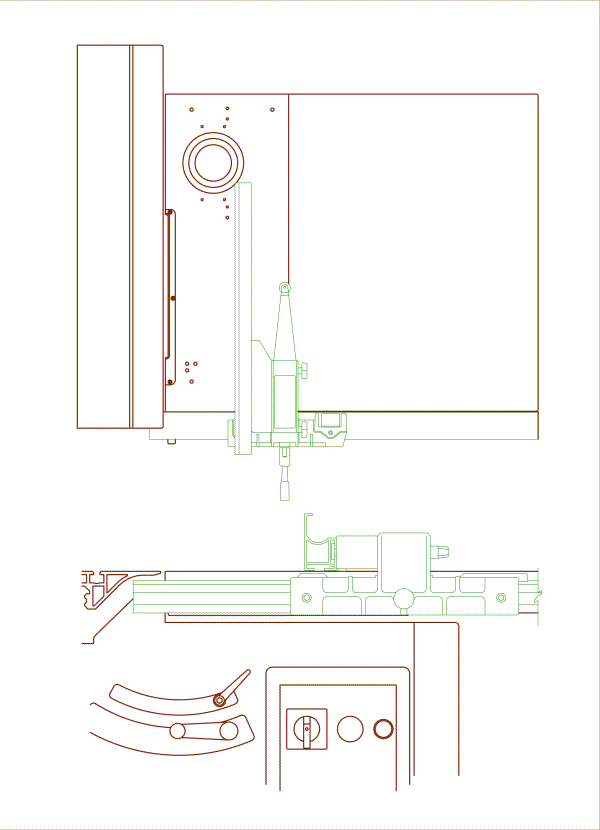
|
Vega
The Vega looks similar to
the Biesemeyer but has several advantages in this application. First, the lock-down clamp
is not part of the fence and would not introduce any problem if the fence were to be
re-located. Second, the fence is attached to the head with four bolts, not welded like the
Biesemeyer. It would be very easy to relocate the bolt holes and move the fence to the
left edge of the head. Because it would be fairly easy to do, a triangular support could
be added between the right side of the rip fence and the T-square head to stiffen the
assembly.
The rail attachment bracket and the round rail of the Vega would
not be affected as adversely to the non-milled table edge in the Hammer like some of the
other solutions.
With this system, items 1, 2, 3, 4, 5, 6, 8, 9, 10, 11, & 14
of the ideal fence system can be achieved; the Vega also has a micro adjust function. Vega
also offers a stock pusher, cut-off device, stock feed roller, and laminate trimmer
accessories that fit onto the fence. The main deterrent to this modification is that the
fence is fixed to the head and cannot be repositioned in the Euro manner. Unlike the
Accufence and Unifence, the Vega does not have a perpendicularity adjustment for the
fence, it is set by the rail. The main benefit of this system is that it is fairly easy to
implement, it's one of the lower cost solutions, and the beneficial Vega accessories
available for it.
Although not described here, the Vega could also be modified in a
manner to use a fence extension like the Accufence adaptation.
|
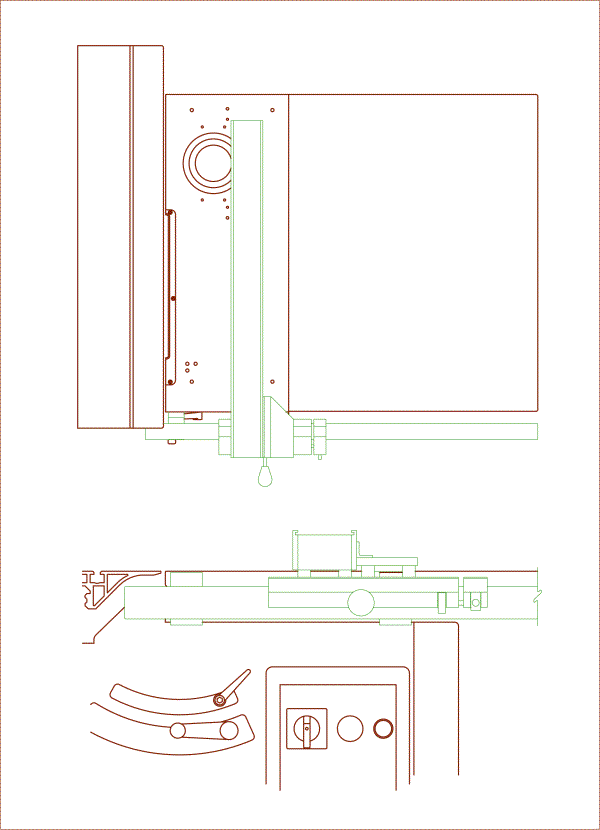
|
European Biesemeyer
According to FOG reports,
Biesemeyer makes a version of their rip fence that can be fitted to a Euro saw like the
Hammer. As I have had no response from my own inquiries, the following information and
picture were supplied to me by another FOG member:
The two part numbers to order for the 30" system
will be B78X99 for the guide set. this P/N is a generic number for guide sets "as per
specs". The dealer would then specify 30" right hand capacity w / sliding table
at the blade. The P/N for the rip fence is B79100W for the 42" Offset fence or P/N
B79200W for the 48" offset fence.
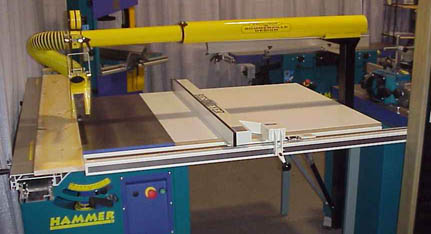
With this system, it looks like items 1, 2, 3, 5,
6, 8, 9, 10, 11, & 14 of the ideal fence system can be achieved. The main detriment of
this fence system is that the fence is fixed to the head and cannot be repositioned in the
Euro manner. The cost is probably a detriment as well along with a well-known issue of an
un-parallel fence when it is moved; this doesn't affect accuracy and could be resolved by
technique. The main benefit of a system like this is that the Biesemeyer locks down very
rigidly and it is a robust design.
Of note is the different right extension table. I don't
have any information on this but it looks like a Biesemeyer product. This particular
implementation would not allow the machine to be as mobile as the OEM extension
|
Excaliber
In order to span the much larger table of a Euro
saw, the largest Excaliber would be required. This is basically a $500+ system,
quite costly for an analog fence. The easiest way to adapt the Excaliber would be to
use a scheme similar to the Accufence modification described above. In this case it would
appear that the T-square head could not be altered and the "make-up" distance to
get the fence up to the saw blade would be between 2 to 3 inches.
Using the Excaliber, items 1, 2, 3+, 4, 5, 6?, 8, 9, 10, & 14
of the ideal fence system may be achieved. The Excaliber also has a micro adjust function
and guide bearings that keep the fence parallel when moved at all times and reduce sliding
friction to a minimum. Excaliber also has a stock pusher device that rides in T-slots in
the fence but if an additional fence were to be fitted, this accessory could not be used
close to the blade (the only place it would be useful). It does appear that it could be
possible to use a dual cursor so that the additional fence could be used only when
desired.
The main benefit of this system appears to be the
very strong locking action, ease of fence movement, and a continuously parallel fence. The
main detriment of the system appears to be the high cost, rail installation and the very
temperamental (but critical) alignment. While one is at it. it would probably be a
good idea to go ahead and improve upon the bad method used by the bearing system of this
fence, basically the bearing run on paint instead of metal.
|
Others
I also investigated other
rip fence systems for use on the Hammer.
The fence system used on the Dewalt 746 tablesaw has the cursor
on the left which would probably be obscured by any modification and the T-square head
itself cannot be shortened. That leaves the option of moving the fence over by several
inches using a big spacer. In my analysis, this fence design would be harder to modify
than the others and therefore less desirable.
I haven't seen the Grizzly Shop Fox (original) in person but I
doubt it could be used since it could not span the table.
I would also prefer the Accufence or Modulus versions of the
Biesemeyer clones over a true Biesemeyer or any other clone. The Biesemeyer style wear
pads aren't as good as the Accufence and the locking mechanism is not as powerful. Both
the Accufence and Modulus units have a locking accessory for the rear of the fence that
might be useful for power feed operations if they could be used.
|
Recommendations
As mentioned in the review, my recommendation would be to
purchase a Euro saw without the ripfence and extension table; they are quite inferior to
what can be bought aftermarket.
Summary
The following chart summarizes where the rip fence systems described herein fall into the
"Ideal Rip Fence" criteria mentioned above.
|
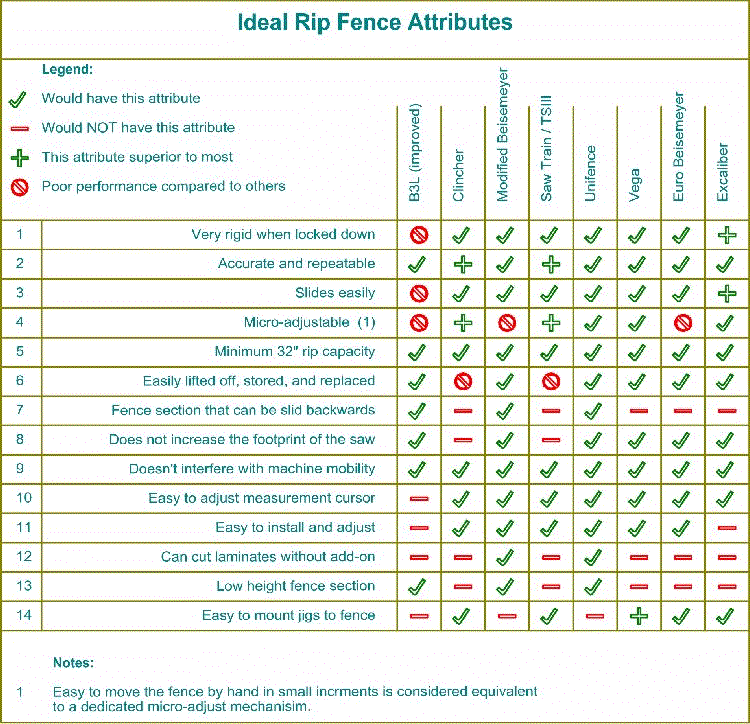
|
|